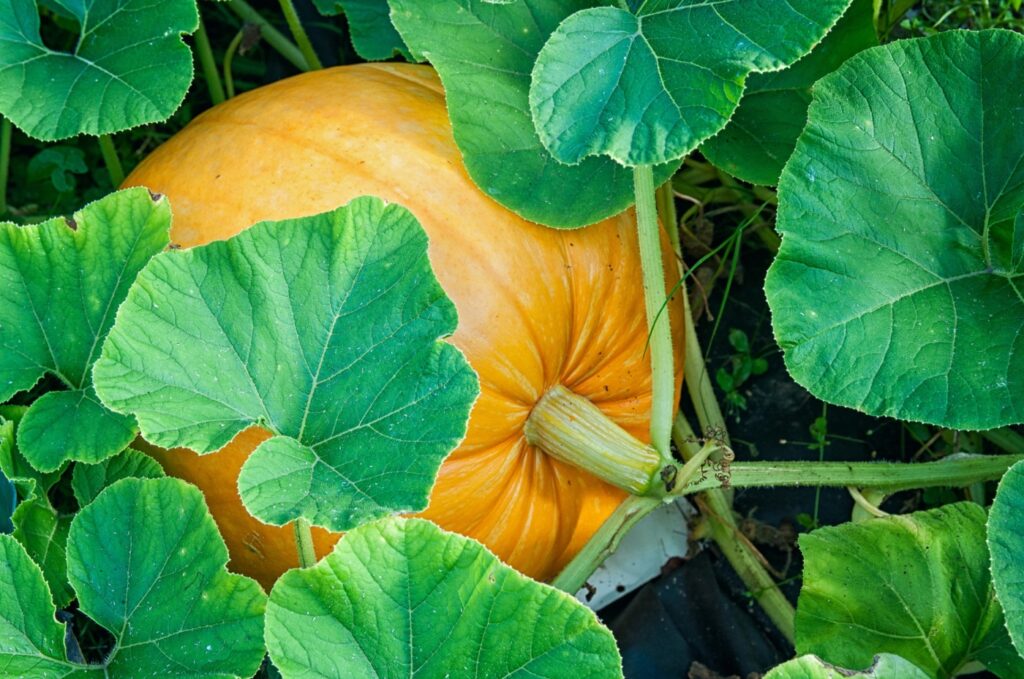
1. You don’t need a farm to grow pumpkins, but you do need all-day sun, fast-draining soil that is well-composted, and lots of space. Vines may trail along for 20 feet or more and you would not want any plants seeking their companionship to get in the way. If you wish to grow large Jack-O-Lantern pumpkins (Cucurbita pepo), you will want to allow four months for them to reach full size. ‘Connecticut Field’ and ‘Howden’ varieties are recommended by Jack Creek Farms, a pumpkin grower north of San Luis Obispo. Pumpkins require rich, well-composted soil and readily available minerals throughout the growing period. Use of a slow-release fertilizer, such as Osmocote Flower and Vegetable Plant Food, is therefore advised. Pumpkin seeds should be planted in the center of the area in which their vines are to spread. Seeds should be planted one-inch deep, either end up, on flat ground where soil drainage is good or, where drainage is less than perfect, on mounds that are three inches tall and 12 inches wide in diameter. Seeds may be planted in groups of six and then, as they become seedlings, thinned to three baby plants. Water frequently at first and, as plants mature, water when soil starts to dry out or leaves are just beginning to wilt. Water copiously and deeply but only as needed. Keep water off of foliage to prevent mildew. When pumpkins begin to turn orange, decrease watering and, to increase storage life, cease watering completely one week before harvest.
2. Speaking of orange, I have been surrounded by orange bloomers this spring, including California poppies, Third Harmonic Peruvian lilies, orange lantana, Judy Garland roses, and orange star flower (Ornithogalum dubium), which I received as a gift and has just stopped flowering. Once its leaves have turned brown, a sign it has stopped making food for next year’s growth, I will remove the star flower bulb and store it in my garage until next spring since it would be in danger of rotting from water applied to surrounding plants during the growing season and, as a cold sensitive species, it could die this fall as soon as temperatures dip below 40 degrees. Meanwhile, I am thoroughly wowed by two reddish-orange flowered beauties that are beginning to bloom like mad and should continue to do so for some time. One is the cigar plant (Cuphea ignea), completely covered with smoldering miniature cigars, and the other is Vancouver Centennial geranium, a horticultural treasure that not only displays reddish-orange blooms but shows off copper colored foliage edged in gold as well.
3. Thrips and giant whiteflies find June especially friendly and their populations can experience explosive growth during this month. Thrips are tiny black threads visible in many flowers, from Peruvian lilies to gardenias and curl the leaves of certain plants, especially the ubiquitous Indian laurel fig (Ficus microcarpa nitida). Control them with ultra-fine horticultural oil or insecticidal soap. Where Indian laurel fig is concerned (if you must plant it, despite its troublesome roots), select the Green Gem variety, which is thrips resistant.
Giant whiteflies are another matter. They are especially attracted to common red-flowered hibiscus, but appear to leave orange and yellow flowered hibiscus untouched, so select these colors instead of the red. Long-term control of this pest involves the introduction of its natural predators, most notably parasitic wasps. Rincon-Vitova Insectary (rinconvitova.com) in Ventura is a highly trusted source for beneficial insects of all kinds, which are readily packaged and shipped to your door.
4. Regarding dandelions, someone who gardens in Orange County asked: “Can one eat the flowers and stems as well as the leaves?” Besides large leafy plants, is it healthy to eat smaller plants with small leaves in drier soil? Is there a difference between the tall plants one to two feet high or the short, ground-level plants with one blossom like those in a lawn? Or should I eat only the greens sold in a market?”
Related Articles
Drought-tolerant lawn replacements: Your gardening and watering questions answered
Watering the garden during drought restrictions: How to prioritize your plants
Where the sun don’t shine: How to get the most out of a shady garden
This refreshing new garden book offers useful money-saving tips
Why these invasive ‘demon trees’ are a problem, and what to plant instead
All dandelions may be eaten, regardless of size. With the exception of their milky stems, all parts of the dandelion are edible, including their roots. Still, please note: You would not want to eat dandelions that have been sprayed with chemical or fertilizer solutions. The young leaves of edible greens of every kind, from lettuce to dandelions, are invariably tastier than older foliage, especially once plants have flowered.
5. June is an excellent month to plant ornamental bananas and ginger. Red banana, Ensete vetricosum ‘Maurelli’, has maroon foliage and is one of the best container plants around, specimens of which are on display at the Descanso Gardens. The flowers of ginger lilies (Hedychium species), in either yellow or white, are among the most fragrant you will encounter and the plants themselves are exceedingly easy to grow. They tower up to eight feet tall and spread with carefree abandon by rhizomes so you will happily have more and more ginger lilies as the years go by. Placed in a vase, ginger lilies provide perfume to a room for an entire week.
Send questions, comments, and photos to joshua@perfectplants.com.
